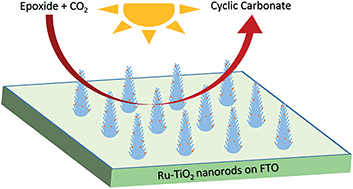Photo-generation of cyclic carbonates using hyper-branched Ru–TiO2
Abstract
Anthropogenic CO2 is the main contributor to the increased concentration of greenhouse gases in the atmosphere, and thus utilising waste CO2 for the production of valuable chemicals is a very appealing strategy for reducing CO2 emissions. The catalytic fixation of CO2 with epoxides for the production of cyclic carbonates has gained increasing attention from the research community in search of an alternative to the homogeneous catalytic routes, which are currently being used in industry. A novel photocatalytic heterogeneous approach to generate cyclic carbonates is demonstrated in this work. Hyper-branched microstructured Ru modified TiO2 nanorods decorated with RuO2 nanoparticles, supported on fluorine-doped tin oxide (FTO) glass were fabricated for the first time and were used to catalyse the photo-generation of propylene carbonates from propylene oxides. Propylene carbonate was used as a reference for cyclic carbonates. The photo-generation of cyclic carbonates from epoxides and CO2 was carried out at a maximum temperature of 55 °C at 200 kPa in a stainless steel photoreactor with a quartz window, under solar irradiation for 6 h. The best performing photocatalyst exhibited an estimated selectivity of 83% towards propylene carbonates under the irradiation of a solar simulator.

- This article is part of the themed collection: Artificial photosynthesis


 Please wait while we load your content...
Please wait while we load your content...